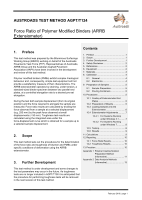Pavement

- Publication no: AGPT-T124-16
- Published: 18 February 2016
- PDF (free) Download
This test method sets out the procedures for the determination of the force ratio and toughness of bitumen and PMBs under specific conditions of deformation using the ARRB extensiometer.
Polymer modified binders (PMBs) exhibit complex rheological behaviour and, consequently, simple test equipment will not provide a satisfactory measure of their characteristics. The ARRB extensiometer operates by straining, under tension, a standard?sized binder specimen between two parallel end plates, at a controlled elongation rate to a desired pre?set elongation.
During the test both sample displacement (from its original position) and the force required to elongate the sample are measured. Force ratio results are calculated by dividing the force observed from a sample at a selected displacement (e.g. 250 mm) by the peak force observed at small displacements (< 50 mm). Toughness test results are calculated using the integrated area under the force?displacement curve which is obtained for a sample up to a selected sample displacement.
- 1. Preface
- 2. Scope
- 3. Further Development
- 4. Safety Disclaimer
- 5. References
- 6. Equipment
- 7. Materials
- 8. Calibration
- 8.1. General
- 8.2. Electronics
- 9. Preparation of Samples
- 9.1. Sample Preparation
- 9.2. Pouring Containers
- 10. Procedures
- 10.1. Coating of Extensiometer End Plates
- 10.2. Preparation of Moulds
- 10.3. Loading Samples into the Extensiometer
- 10.4. Extensiometer Adjustments
- 10.4.1. For Systems Running under Windows 3.1
- 10.4.2. For Systems Running under Windows 7
- 10.5. Testing
- 10.6. Results
- 11. Calculations
- 12. Reporting
- 12.1. Force Ratio Results
- 12.2. Toughness Results
- 13. Precision
- Appendix 1 Polymer Coating Solution Preparation Method (Informative)
- Appendix 2 Data Analysis Methods (Informative)
